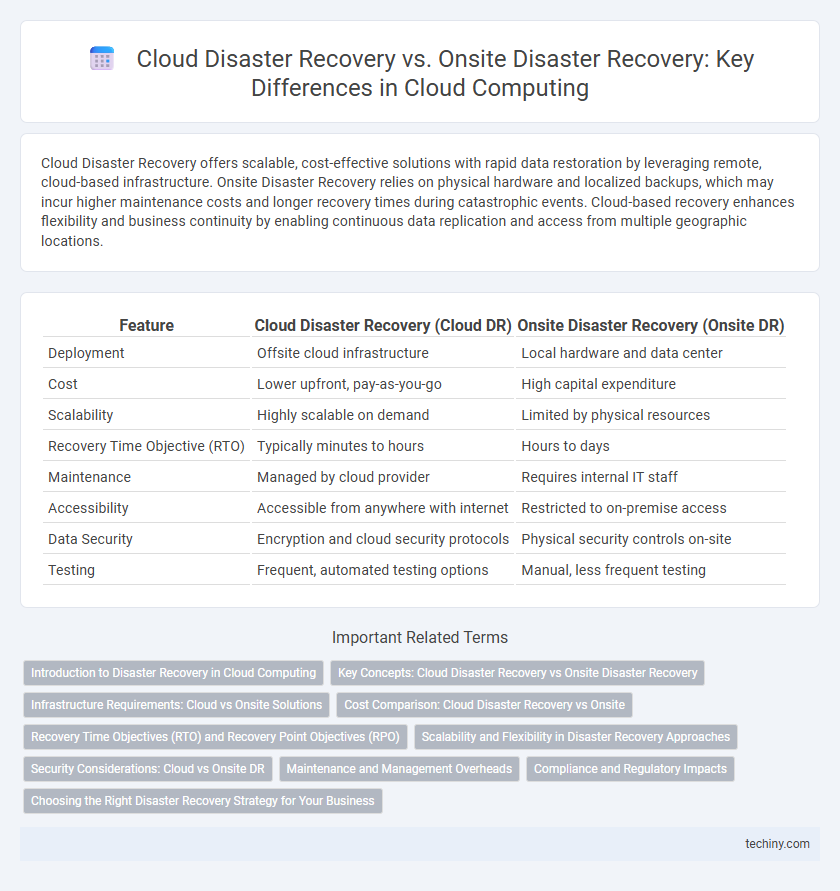Cloud Disaster Recovery offers scalable, cost-effective solutions with rapid data restoration by leveraging remote, cloud-based infrastructure. Onsite Disaster Recovery relies on physical hardware and localized backups, which may incur higher maintenance costs and longer recovery times during catastrophic events. Cloud-based recovery enhances flexibility and business continuity by enabling continuous data replication and access from multiple geographic locations.
Table of Comparison
| Feature | Cloud Disaster Recovery (Cloud DR) | Onsite Disaster Recovery (Onsite DR) |
|---|---|---|
| Deployment | Offsite cloud infrastructure | Local hardware and data center |
| Cost | Lower upfront, pay-as-you-go | High capital expenditure |
| Scalability | Highly scalable on demand | Limited by physical resources |
| Recovery Time Objective (RTO) | Typically minutes to hours | Hours to days |
| Maintenance | Managed by cloud provider | Requires internal IT staff |
| Accessibility | Accessible from anywhere with internet | Restricted to on-premise access |
| Data Security | Encryption and cloud security protocols | Physical security controls on-site |
| Testing | Frequent, automated testing options | Manual, less frequent testing |
Introduction to Disaster Recovery in Cloud Computing
Disaster recovery in cloud computing leverages scalable, offsite resources to restore critical data and applications quickly after disruption, minimizing downtime and data loss. Cloud disaster recovery offers automated backup, geographic redundancy, and flexible recovery point objectives (RPO) compared to traditional onsite disaster recovery that relies on physical hardware and localized infrastructure. Enterprises adopting cloud-based DR solutions benefit from cost efficiency, rapid recovery time objective (RTO), and enhanced resilience against natural disasters or cyberattacks.
Key Concepts: Cloud Disaster Recovery vs Onsite Disaster Recovery
Cloud disaster recovery leverages remote cloud infrastructure to replicate and restore data, offering rapid recovery times and scalable resources during outages. Onsite disaster recovery relies on physical hardware and local backups, which may result in higher recovery times and limited scalability due to hardware constraints. Key differences include cost efficiency, recovery speed, and flexibility, with cloud solutions providing automated backup and geo-redundancy that onsite methods often lack.
Infrastructure Requirements: Cloud vs Onsite Solutions
Cloud disaster recovery requires minimal physical infrastructure, leveraging virtualized resources hosted by third-party providers, which reduces capital expenditure and maintenance overhead. Onsite disaster recovery demands extensive physical hardware, dedicated data centers, and significant IT personnel for upkeep and rapid response, increasing both cost and complexity. Cloud solutions offer scalability and resource optimization, while onsite setups require pre-allocated, often underutilized, infrastructure to ensure readiness.
Cost Comparison: Cloud Disaster Recovery vs Onsite
Cloud disaster recovery significantly reduces upfront capital expenditures by eliminating the need for physical hardware and maintenance costs associated with onsite solutions. Operational expenses are scalable in cloud recovery, allowing businesses to pay only for the resources they use, contrasting with fixed costs in onsite disaster recovery. Cloud-based recovery also minimizes downtime costs due to faster data restoration, enhancing overall cost efficiency compared to traditional onsite methods.
Recovery Time Objectives (RTO) and Recovery Point Objectives (RPO)
Cloud Disaster Recovery typically offers lower Recovery Time Objectives (RTO) and Recovery Point Objectives (RPO) compared to onsite disaster recovery due to its scalable, automated infrastructure and geographically dispersed data centers. Cloud solutions enable near-instant data replication and faster system restoration, minimizing downtime and data loss. Onsite disaster recovery may face longer RTO and RPO because of physical limitations and slower manual recovery processes.
Scalability and Flexibility in Disaster Recovery Approaches
Cloud disaster recovery offers superior scalability by leveraging virtualized resources that can be rapidly adjusted to meet evolving demands, while onsite disaster recovery relies on fixed physical infrastructure with limited expansion capacity. Flexible recovery options in cloud environments enable organizations to customize backup schedules, replication frequencies, and recovery point objectives with ease, unlike onsite solutions that often require manual reconfiguration and hardware upgrades. Organizations benefit from the elastic nature of cloud disaster recovery, ensuring continuous availability and quicker adaptation to changing business requirements compared to the rigidity of onsite systems.
Security Considerations: Cloud vs Onsite DR
Cloud disaster recovery (DR) offers enhanced security measures such as data encryption, automated backups, and geographically distributed data centers that reduce risks of physical damage and unauthorized access. Onsite disaster recovery relies heavily on physical security controls and local infrastructure, which can be vulnerable to natural disasters, theft, or hardware failures. Businesses must evaluate compliance requirements, data sensitivity, and response times when choosing between cloud DR's scalable security features and onsite DR's direct control over data environments.
Maintenance and Management Overheads
Cloud disaster recovery significantly reduces maintenance and management overheads by outsourcing infrastructure updates, backups, and failover processes to cloud providers with automated systems. Onsite disaster recovery requires extensive in-house resources for hardware upkeep, software patching, and continuous monitoring, increasing labor costs and complexity. Cloud solutions offer scalability and streamlined management, minimizing downtime and manual intervention compared to traditional onsite methods.
Compliance and Regulatory Impacts
Cloud disaster recovery offers enhanced compliance with industry regulations by ensuring data encryption, automated backups, and audit trails that meet standards such as GDPR, HIPAA, and SOC 2, reducing the risk of non-compliance penalties. Onsite disaster recovery often requires substantial manual processes to maintain compliance documentation, making it vulnerable to human error and regulatory gaps during incidents. Cloud solutions enable faster compliance reporting and data sovereignty controls, critical for organizations operating in highly regulated environments.
Choosing the Right Disaster Recovery Strategy for Your Business
Cloud disaster recovery offers scalable, cost-effective solutions with rapid data restoration using offsite servers, ideal for businesses requiring flexibility and minimal downtime. Onsite disaster recovery provides direct control and faster physical access to backup infrastructure, suitable for organizations with strict compliance needs or limited internet connectivity. Evaluating recovery time objectives (RTO), budget constraints, and regulatory requirements ensures the right disaster recovery strategy aligns with your business continuity goals.
Cloud Disaster Recovery vs Onsite Disaster Recovery Infographic

 techiny.com
techiny.com